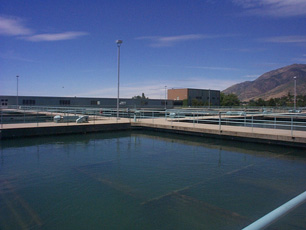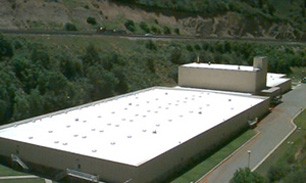Salt Lake County Water Suppliers Cope With Water Supply Interruption
A construction incident takes out the Jordan Aqueduct in Utah County
October 28, 2011
LeRoy W. Hooton, Jr.
Water issues from damaged section of the Jordan Aqueduct (JA4) located in Pleasant Grove, Utah. Photo courtesy of Gordon Bell.
On August 24, 201l, a bulldozer working on the Provo Reservoir Canal Enclosure Project in Pleasant Grove, accidentally tore a hole in the 72-inch raw water Jordan Aqueduct which supplies water to Salt Lake County. On one of the hottest days of this past summer, the aqueduct was flowing at maximum capacity of 175 million gallons per day (mgd). The incident interrupted this supply and triggered action by Salt Lake County's water suppliers to keep water flowing to their customers on a county-wide basis. The Jordan Valley Water Conservancy District (JVWCD), Metropolitan Water District of Salt Lake & Sandy (MWDSLS) and Salt Lake City Department of Public Utilities (SLCDPU) collaborated to make system adjustments to compensate for the loss of this major source of water supply during a period of high demand. These adjustments were made possible by critical infrastructure, interconnections between the various systems, alternative water reserves and splendid cooperation among the County's water managers.
The Jordan Aqueduct Configuration
Raw water from the Provo River is diverted and conveyed in the old Utah Power & Light Olmstead Flowline for 4.5 miles in Provo Canyon where the flow then transitions into the Jordan Aqueduct, which transverses northern Utah County parallel to the Provo Reservoir Canal. The aqueduct then continues into Salt Lake County to the Jordan Valley Water Treatment Plant (JVWTP) located in Bluffdale. The treated water effluent from the JVWTP continues to flow in the finished water Jordan Aqueduct along the west side of the Salt Lake valley terminating at Salt Lake City's boundary at 3800 West 2100 South. At 5820 South there is a 100 million gallon distribution reservoir. The aqueduct supplies M&I water to JVWCD's customer agencies along the length of the pipeline. MWDSLS supplies water to Salt Lake City at the end of the pipe, providing water supply to the City's Northwest Quadrant.
The water treatment plant and finished water aqueduct were constructed as part of the Central Utah Water Project in the 1980s. The capacity of these facilities is prorated 5/7th and 2/7th between JVWCD and MWDSLS respectively. In 2007, the Central Utah Water Conservancy District deeded the treatment plant and reservoir over to JVWCD and MWDSLS.
The Response to the Accidental Damage to the Jordan Aqueduct
When the bulldozer accident happened, it was necessary to shut down the raw water segment of the Jordan Aqueduct to make the necessary repairs. According to General Manager Richard Bay, JVWCD requested that more than 600,000 customers living west of the Jordan River stop outdoor watering. The request affected West Valley, West Jordan, South Jordan, Draper, Riverton, Herriman, Bluffdale, Kearns and Magna.
In order to adjust for the loss of this major water supply, the County's water suppliers worked together to make system adjustments to compensate for the loss. JVWCD, besides requesting its customers stop outside watering, turned on additional wells to bolster the water supply within its service area.
According to Assistant General Manager Michael DeVries, MWDSLS in collaboration with SLCPU and JVWCD operated its facilities to maximize water deliveries to the Salt Lake Valley residents during the emergency situation.
|
MWDSLS drew additional water from Deer Creek Reservoir into the raw water Salt Lake Aqueduct (SLA) increasing the flow from 81 to 108 mgd – its maximum capacity; thirteen mgd of this flow was diverted from the SLA into the JVWCD's South East Region Water Treatment Plant for delivery directly into JVWCD's distribution system. Additionally, MWDSLS increased the flow of its Little Cottonwood Water Treatment Plant (LCWTP) from 102 to 121 mgd, thus increasing the flow in the Point of the Mountain Aqueduct (POMA) from 15 to 44 mgd, which in part was delivered to the JVWCD system through a connection at 150th South. Another 6 mgd of water from the Point of the Mountain Water Treatment Plant (POMWTP) increased the total flow to JVWCD through this connection to 35 mgd. “This incident,” said DeVries, “has provided a tangible example of the benefit and value of this interconnection between the MWDSLS and JVWCD drinking water systems.”
Recent MWDSLS capital investments have greatly improved the ability to conjunctively operate MWDSLS and JVWCD's systems. The construction of POMWTP and POMA has made it possible to move water from one system to another at the 150th South interconnection. For example, water can now be moved in both directions in POMA; either south from the LCWTP or north from POMWTP. “Delivering water to the JVWCD [from the LCWTP] wouldn't have been possible without POMA being constructed,” said MWDSLS General Manager Michael Wilson.
SLCDPU turned on one well that delivered 3 mgd of additional water supply into the system. Also, it increased water production from its water treatment plants located on Wasatch Canyon streams in Salt Lake County. This additional water supply was conveyed to the City's westside by adjusting Pressure Regulating Valves (PRVs) to bleed water through the distribution grid from the eastside pressure zone into the westside pressure zone to make up for the water supply lost as a result of the Jordan Aqueduct incident.
The damaged Jordan Aqueduct was repaired and placed back into service about 26 hours after the accident first occurred. Despite the potential for water shortages, the collaborative action of the water suppliers averted any interruption of water service within Salt Lake County.
|
The accident was unfortunate, but did provide an opportunity to test the County's water suppliers' ability to cope with an emergency situation of this magnitude.
SLCDPU Director Jeff Niermeyer credited planning and conjunctive management plans that have been developed over the last decades. “[They] have shown to be a prudent and necessary step in providing our communities with a robust and resilient water supply,” said Niermeyer, continuing. “The incident also shows how vulnerable we are when there is damage to the major aqueduct systems feeding Salt Lake County; however by the water community working together, we can address these vulnerabilities.”
![08 24 11 PRCE JA4 rupture 1150 to 1155 (1)[1] 08 24 11 PRCE JA4 rupture 1150 to 1155 (1)[1]](../images/08_24_11_PRCE_JA4_rupture_1150_to_1155__1__1_.JPG)

